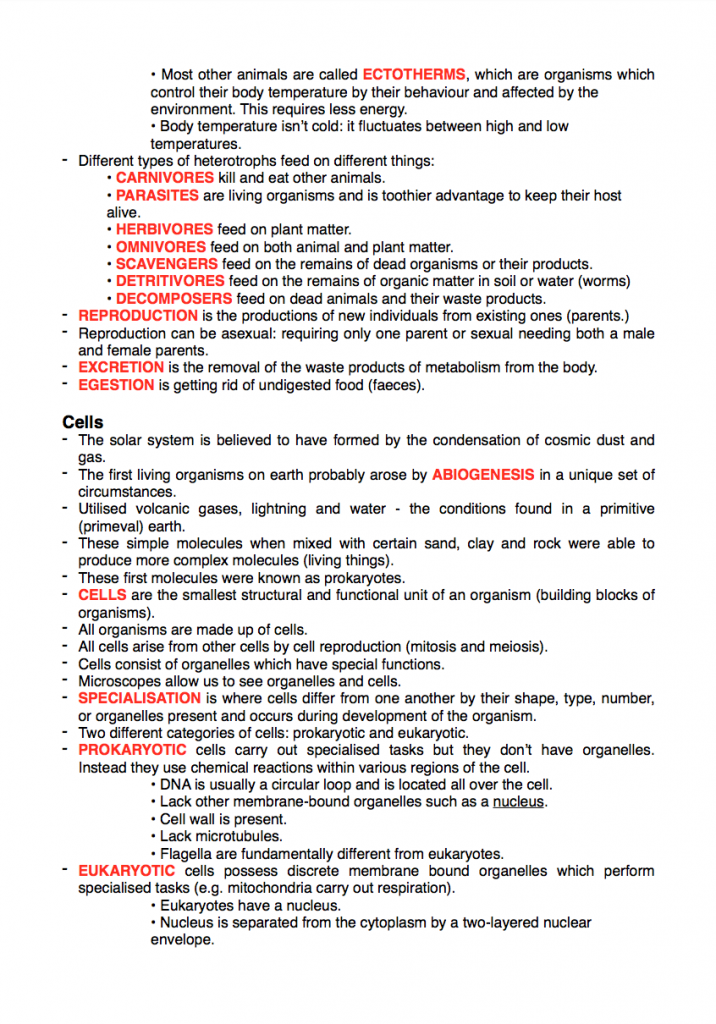A complete term’s worth of extensive biology notes regarding the topic of Classification. These notes cover, in thorough detail, the following learning intentions:
(1) Characteristics of Living Things: distinguishing between organic and inorganic molecules, the characteristics of living things and the importance of metabolism in living organisms.
(2) Types of Nutrition: definitions and explanations of autotrophs, photosynthesis, chemosynthesis, heterotrophs, consumers, respiration, endotherms, ectotherms, carnivores, parasites, herbivores, omnivores, scavengers, detritivores, decomposers, excretion, egestion and reproduction.
(3) Cells: a brief overview of cell theory, including the process of abiogenesis, cells, specialisation, distinguishing between prokaryotic and eukaryotic cells and plant and animal cells, as well as a brief explanation of cell organelles including the nucleus, mitochondria, ribosome, lysosome, cilia/flagella, cell membrane, vacuole and chloroplasts.
(4) Classification: an overview of classification, including terms such as natural classification, taxonomy, binomial nomenclature, phylogenetic tree, hierarchical system (domain, kingdom, phylum, class, order, family, genus and species), species, variation, subspecies and breeds.
(5) Viruses
(6) 5 Kingdoms & Lichens: an extensive overview of the 5 Kingdoms including Monera, Protista, Fungi, Animalia and Plantae as well as the importance of the symbiotic relationship between algae and fungi to form Lichen.
(7) Phyla of the Animal Kingdom: a list of the criteria in classifying animals, a list of the distinguishable characteristics and examples in each phyla including Phylum Porifera, Cnidaria, Platyhelminthes, Nematoda, Annelida, Echinodermata, Mollusca, as well as the classes including Class Bivalva, Gastropoda, Cephalopoda, Polyplacophora, Phylum Arthropoda, including the classes Class Arachnida (Chelicerata), Crustacea (Malacostraca), Diplopoda (Myriapoda), Chilopoda and Insecta, Phylum Chordata including subphyla such as Subphylum Urochordata, Cephalochordata and Vertebrata and classes Class Agnatha, Chondrichthyes, Osteichthyes, Amphibia, Reptilia, Aves and Mammalia, including the subclasses of Subclass Monotremes, Marsupials and Placental Mammals.
(8) Phyla of the Plant Kingdom: a list of the criteria in classifying plants, a list of the distinguishable characteristics and examples in each phyla including Phylum Bryophytes, Tracheophytes, Filicinophyta (including the alternation of generations), Coniferophyta (gymnosperms), Ginkgopsida, Cycadopsida, Angiospermophyta (angiosperms) including the subphyla such as Subphylum Monocotyledons and Dicotyledons.
(9) Parts of a Flowering Plant: a brief overview of the structure of an angiosperm, including the stamen, anther, filament, pistil, style, stigma, ovary, sepals and petals.
(10) Classification Keys: a list of criteria used to establish classification keys, including dichotomous keys, numerical dichots and graphical dichots.



Reviews